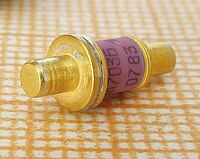
Photo from wikipedia
The impedance-ratio criterion is widely adopted for analyzing the small-signal stability of systems with cascaded power electronic converters. However, the impedance ratio is formed differently for different cascaded systems. In… Click to show full abstract
The impedance-ratio criterion is widely adopted for analyzing the small-signal stability of systems with cascaded power electronic converters. However, the impedance ratio is formed differently for different cascaded systems. In this paper, a generic impedance-sum criterion is proposed for the stability of general power electronic systems with two converters/sources. The two converters/sources can be in parallel operation, such as parallel-operated voltage-controlled inverter systems in microgrids and parallel-operated current-controlled inverter systems, or in series (cascaded) operation, such as cascaded DC/DC converter systems and grid-connected current-controlled converters. In this paper, it is shown at first that in order for a converter/source to be stable both the impedance and its inverse should be stable, that is, the impedance should not have any right-half-plane (RHP) zeros or RHP poles. Then, it is shown that a system with two individually stable converters/sources is stable if and only if the sum of the individual impedances does not have any RHP zeros or, equivalently, the impedance sum does not encircle the origin clockwise. This generic criterion is then demonstrated via applications covering all four possible cases.
Journal Title: IEEE Access
Year Published: 2019
Link to full text (if available)
Share on Social Media: Sign Up to like & get
recommendations!